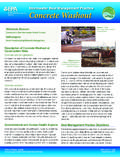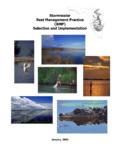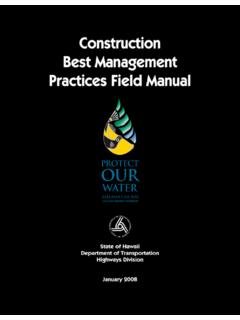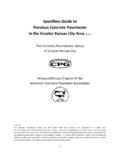Transcription of Polycyclic Aromatic Hydrocarbons, Coal-Tar …
1 stormwater best management Practice P olycyclic Aromatic Hydrocarbons, Coal-Tar Sealcoat, and stormwater PollutionMinimum MeasurePollution Prevention/Good HousekeepingWhat are the sources of Polycyclic Aromatic hydrocarbons in the environment? Polycyclic Aromatic hydrocarbons (PAHs) are persistent organic compounds. These chemicals come from both natural and man-made sources. PAHs are naturally released in the environment from wildfires, volcanic eruptions, and degradation of biological materials contained in various sediments and fossil fuels (CDC/ATSDR, 1995; White and Lee, 1980). Man-made sources of PAHs in the environment include the incomplete burning of organic materials ( , coal, oil, gas, wood, garbage); vehicle exhaust; asphalt; Coal-Tar and Coal-Tar based sealcoats; creosote; and cigarette and tobacco smoke (CDC/ATSDR, 1995; CDC, 2009; EPA, 2009; National Research Council, 2009).
2 Many PAHs are of concern because of their harmful impacts on humans and the environment. They are persistent organic compounds; several PAHs are known or probable human carcinogens and toxic to aquatic life (Integrated Risk Information System (IRIS), 2014; Scoggins, McClintock, Gosselink, and Bryer, 2007).What Is Coal-Tar Sealcoat? Coal-Tar sealcoat is a type of sealant used to maintain and protect driveway and parking lot asphalt pavement. Coal-Tar sealcoat typically contains 20 to 35% coal tar pitch, a byproduct of the steel manufacturing industry, which is 50% or more PAHs by weight (Mahler, Van Metre, Bashara, Wilson, and Johns, 2005).Could Coal-Tar Sealcoat Be a Concern for stormwater ?
3 Studies found that PAHs are significantly elevated in stormwater flowing from parking lots and other areas where Coal-Tar sealcoats were used as compared to stormwater flowing from areas not treated with the sealant. For example, one study found the amount of PAHs in stormwater runoff was 65 times higher from parking lots sealed with Coal-Tar sealant vs. stormwater from unsealed parking lots (Mahler et al., 2005). Another study found that Coal-Tar sealcoat is the largest source of PAHs when averaged across 40 urban lakes across the (Van Metre and Mahler, 2010). PAHs from Coal-Tar sealcoat may accumulate in the sediment of stormwater ponds, requiring expensive disposal of the dredged PAH-contaminated sediment (Mahler et al.)
4 , 2012).State and Municipality Examples Addressing PAHs from Coal-Tar SealcoatSeveral states and cities have taken action to address PAHs from Coal-Tar sealcoat. The following are some notable examples: The city of Austin, Texasbanned the sale and useof Coal-Tar containingpavement sealants in2005: The District of Columbiabanned the sale and use of Coal-Tar sealcoat in 2009: In 2009, Minnesota restricted state agencies frompurchasing undiluted coal tar-based sealant and directedits Pollution Control Agency to study the environmentaleffects of coal tar-based sealants and to developmanagement guidelines: Washington State banned the sale of Coal-Tar pavementsealants on January 1, 2012 and banned the use of suchsealants after July 1, 2013: of Water, 4203 -fact-sheet #eduEPA 833-F-12-004 January 2018 stormwater best management Practice.
5 Coal-Tar Sealcoat, Polycyclic Aromatic Hydrocarbons, and stormwater PollutionAlternatives to Coal-Tar SealcoatPavement options such as pervious concrete, permeable asphalt and paver systems do not require sealants. These types of pavements allow for stormwater to naturally infiltrate, resulting in decreased runoff. For More InformationFor more information you can watch EPA s webinar stormwater , Coal-Tar Sealcoat and Polycyclic Aromatic Hydrocarbons available at: # information on assessing the toxicity of PAHs in sediment see: from EPA s Office of Research and , you can visit the USGS webpage on PAHs and Coal-Tar -based pavement sealcoat: Polycyclic Aromatic Hydrocarbons (PAHs).
6 2009. Brownfields Profile Glossary. =&glossaryName=Brownfields%20 Profile%20 Glossary#.EPA. 2014. EPA s Integrated Risk Information System (IRIS). , ; Van Metre, ; Bashara, ; Wilson, ; Johns, 2005. Parking lot sealcoat: An unrecognized source of urban PAHs. Environ. Sci. Technol. , ; Van Metre, ; Crane, ; Watts, ; Scoggins, M.; Williams, 2012. Coal-Tar -based pavement sealcoat and PAHs: Implications for the environment, human health, and stormwater management . Environ. Sci. Technol. Research Council. 2009. Urban stormwater management in the United States. (pre-publication version).Scoggins, M.; McClintock, ; Gosselink, L.; Bryer, P. 2007. Occurrence of Polycyclic Aromatic hydrocarbons below Coal-Tar -sealed parking lots and effects on stream benthic macroinvertebrate communities.
7 Journal of the North American Benthological Society. Metre, and Mahler, 2010. Contribution of PAHs from Coal-Tar pavement sealcoat and other sources to 40 lakes. Sci. of the Total Environ., 2010 , C. and M. Lee, 1980. Identification and geochemical significance of some Aromatic components of coal. Geochimica et Cosmochimica Acta, 1980. (80) sheet disclaimer.















